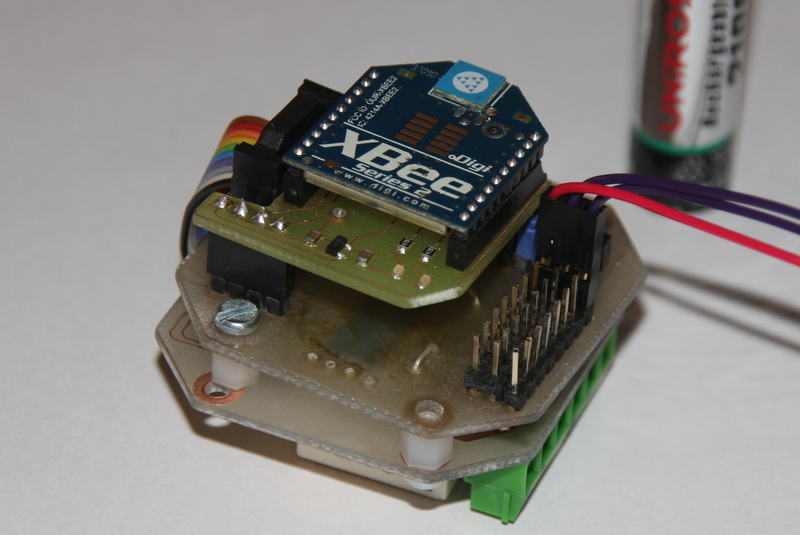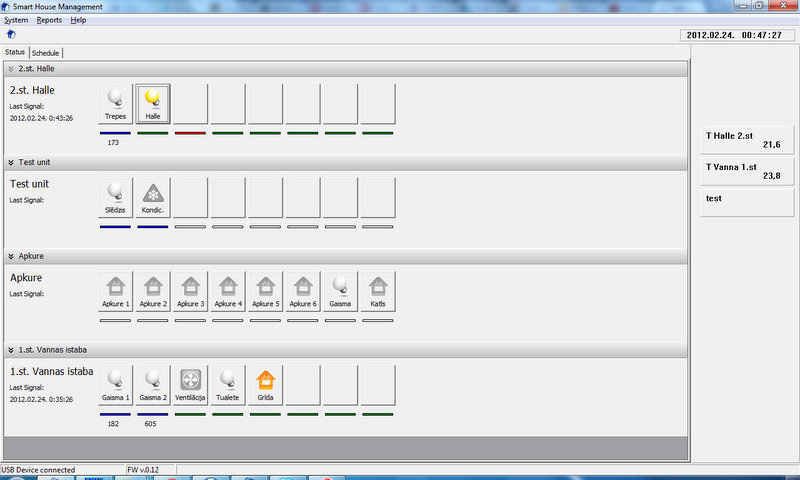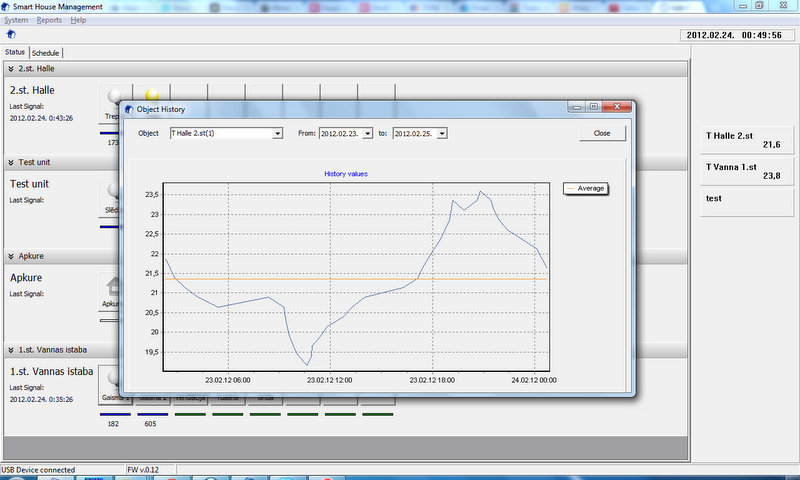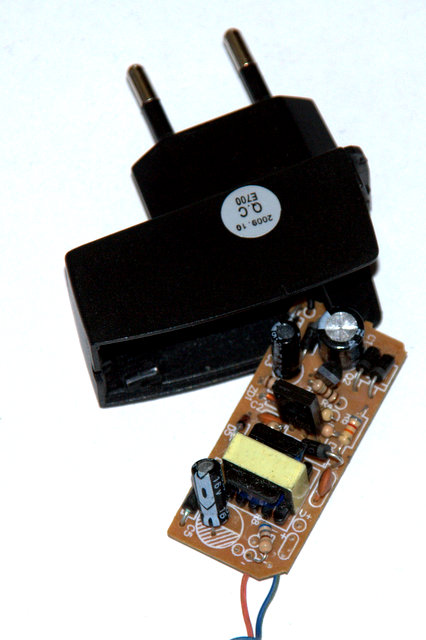Since 2009 I have two generations of the devices created, and currently working on third.
What can I do with the system:
- Devices use ZigBee for communication, so no changes in a current power line wiring needed.
- Devices can be put behind switches or power sockets (deeper boxes are needed to support an additional device behind a switch mechanics).
- A single device can control from 4 to 8 inputs, where any input can be analog or digital. Analog inputs are used for analog sensors, like temperature, light or any other analog sensor. Digital inputs are used for switches.
- Each device can manage from 2 to 5 power lines using relays.
- Devices do not need a central device and can work independently, so if there is any failure with a central device, end device will still work managing power lines according to configuration stored in a device.
- Flexible configuration – all inputs can manage the same output and act as paired switch, or one switch can manage several power lines.
- Custom devices are created for specific purposes, like heating system management device with built in switches or remote inputs, capable to manage 8 power lines.
- Power lines controled by single device can be extended to virtually any number with custom devices created.
- The central system is storing and visualising information from devices – state of inputs, values of inputs (for analog sensors), state of outputs.
- The central system provides an automation capability using any device data to control any other device. For example, having a temperature less than 19 degrees in any room, and if it is saturday and time is between 9AM and 4PM and external light level is less than selected threshold, a heating system can be turned on. Or another example, having an alarm system armed, system will turn of all lights at a house, and when an alarm system is disarmed, it will turn on a light at entrance if an external light level is less than selected threshold.
Let’s start with a central module:
Basically it is the same technical solution what I had in my prototype, only the firmware has been changed and updated and the device has been put into nice box. As the box is partially transparent, LED’s are visible through it. The device has reset and programing mode buttons (to be used with USB bootloader) as well an ICSP header. Device could be made smaller, but it was not a goal in this case.
As end devices there are several options available. A smaller device with 4 inputs and 2 power lines managed:
Or a bigger device with 8 inputs and 5 power lines managed:
And of course few specific purpose devices are also created – 8 power lines and remote sensor inputs:
This is how it looks like when a device is built into walls:
This partcular device is built into a wall between two rooms, and controls power lines for both rooms and below is configuration for this single device
Inputs:
- Two light switches in room 1
- One light switch in room 2
- Temperature reading in room 1
- Temperature reading in room 2
- Ventilation switch for room 1
- Unused switch for room 1
- Floor heat reading using termistor from original heating system. An original regulator failed already twice there, so I was quite motivated to replace an original device with my own, as price of my device was less than new original regulator device 🙂
Outputs:
- Two light power lines for room 1
- One light power line for room 2
- Electric floor heating for room 1
- Ventilation for room 1
And of course, there is a software needed to manage all these things together:










One quick question. Where are you getting the the power for the XBee module? It takes 3.3v right? What are you using to convert the 120v AC to 3.3v DC?
I use miniature 220vac->5vdc power supplies – disassembled cheap usb/mobile phone chargers perfectly suit there. Whole device can be powered by 5-10 volts DC, and there is one LDO 5vdc voltage stabilizer to supply with a voltage microcontroler and relays, and second stabilizer for 3vdc to power XBEE module. Currently working on device, which will include 110/220vac power supply as part of device.
OK.. I am trying to find a good way to power my devices. I am building some devices just like yours (an XBee module connected to some latching relays) but am not sure how to power them. I also found a good part for a 3.3v or 5v buck/boost converter… It allows you to supply (2v-6v) and it will give your a specific 3.3 or 5v supply.
http://www.circuitsathome.com/dc-dc/low-cost-step-up-down-120ma-dc-dc-converter
If possible can you show an image of the part your are using to do the 120 to 5vc conversion?
Thanks.
depending on the current you need to run your device and safety requirements, you can build and use some simple transformerless power supply if max current does not exceed some 100mA and there is no need to isolate mains from device, however, if you need higher currents, one of the cheapest and easiest options are usb/phone chargers, which will supply you with 5+vdc and currents up to 1A; and disassembled you will find there easy to use modules in size up to 3x5cm.

This one has size 2x5cm, supplies 6vdc@500mA, originally was some 3rd party made Samsung phone power supply. when it gets built into wall, I use some heat-shrink tube to isolate it from environment.
After such powersupply I use MCP1802 type 5V regulator for microcontroller (to allow input voltages up to 10V) and MCP1700 type regulator for 3vdc to power XBee part. If you use mains power, then there is no sense to use boost technologies.
I stumbled across you xbee home automation blog and thought you might give me some guidance. The project I am looking at will be similar to what you are doing with a few extras. I have a home that radiant in floor heating, x10 lighting controls and a security system.
The security system was the original goal as I cannot get GSM or Internet accessto this, and the x10 software for remote access is useless.
So I would like to create a system with and olinuxino/android as the brains to control my heating and lighting as well as monitoring motion sensors and door/window closures. I am a software engineer so the programming of the olinuxino should be fairly easy. But I have never done any thing with zigbee/zbee and it looks like a nice way to do it. Any suggestions would be very helpful. If you were to do it again would you use the xbee devices?
For you lighting control, did you use relays or triacs for swithing?
Configuring the xbees and getting info from the xbee devices is fuzzy to me right now. Examples are always helpful.
Thanks in advance.
xbee is nice solution if you are prototyping, so yes, I would use them to proof the concept definitely. With more time available, probably would try to reduce costs, as xbee is most expensive component and I’m not using it’s input/output capabilities, so would probably go with some smaller and cheaper zigbee chips and implement zigbee stack in micro controller application, but for few devices it is not quite worth to do it.
I was using relays – was not sure about power consumption of managed AC lines, but latest device version is more oriented on a triac usage. there are several nice triacs and optocouplers in one case and they can be driven with just a few milliamps and even directly from a micro controller. still have to ensure that the power consumption of the managed AC chain is not exceeding max power of those small triacs, but in such case bigger triac could be used.
configuration of xbees is fairly simple, make one device as coordinator, and others as routers (most optimal, if powered by AC power supply). After powering them up, they will create network, so you just have to deal with API and send/receive messages.
Thanks. Yes they are a little expensive, but the cost of a motion sensor or door/window closure switch could be less expensive that comercial sercurity system sensors. The cost of a motion sensor for my current system is about $70 us, and door switches $45. The cost of the little xbee cards at a cost of $19 makes it possible to be chaper than that. ordered 3 of them so I can get started with them experimenting.